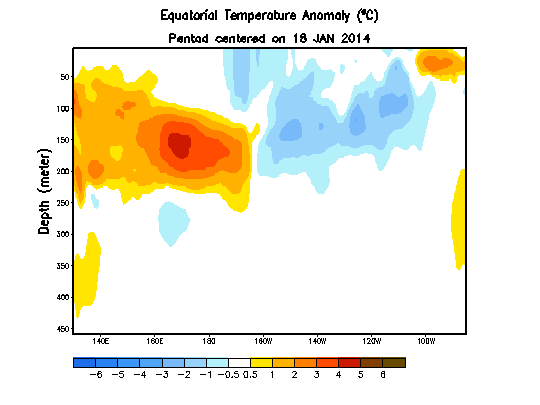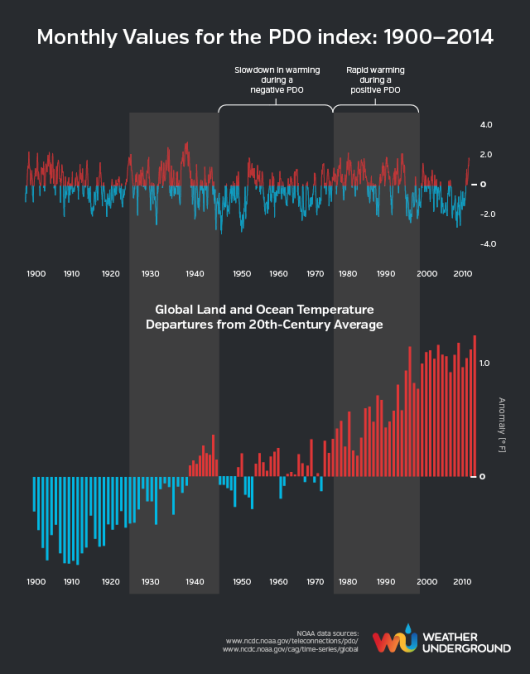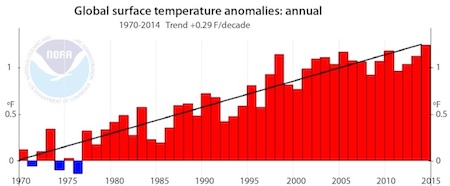Bad
Climate Outcomes — Atmospheric Warming to Ramp up as PDO Swings
Strongly Positive?
26
February, 2015
Last
year, quietly and without much fanfare from the mainstream press, the
Pacific Ocean underwent a powerful shift. A shift from a state in
which cooler surface waters absorbed atmospheric heat, to a phase in
which surface water warming caused ocean heat to be transferred to
the world’s already warming air.
The
shift was heralded by a powerful oceanic Kelvin Wave.
One that brought warm water up from the depths and spread them across
the Pacific Ocean surface. Ever since that time, warm Kelvin Waves
have continued to refresh this surface water heat pool.
(Major Kelvin Wave that heralded a switch to strongly positive PDO values for the Pacific. Image source: NOAA/ESRL)
And
so the Pacific Ocean surface warming continued throughout 2014.
By
December, Pacific Decadal Oscillation (PDO) values, a measure
directly tied to this warming, hit a new all-time record level of
+2.51. That’s the highest and hottest PDO value since
record-keeping began in 1900. One that only backed off slightly into
January at +2.45 in the preliminary measure.
It’s
a major swing in Pacific Ocean surface temperatures to a phase where
more heat is dumped into the atmosphere.
One that is causing some scientists to warn that a new period of
rapid atmospheric warming may just be getting started.
(Sea surface temperature anomaly map shows very warm surface waters dominate much of the equatorial, eastern and northern Pacific in a signature that is strongly characteristic of a powerfully positive PDO on Thursday, February 26 2015. Image source: Earth Nullschool. Data Source: Global Forecast Systems Model.)
PDO
and The Multi-Decadal Heat Pump
Pacific
Decadal Oscillation (PDO) is a periodic change in sea surface
temperature states in the Pacific. One that is thought by many
oceanic and atmospheric researchers to have a strong influence on
global weather and temperature variability.
In
the negative state, PDO tends to encourage La Nina events which also
coincide with a downswing in global temperatures as the vast Pacific
waters take in more heat. In the positive state, PDO tends to
encourage El Nino events which result in the great ocean belching
heat into the air on a grand scale — pushing atmospheric
temperatures higher.
All
things being equal, this natural variability would pan out —
marking upswings and downswings in a global average. However, human
fossil fuel burning and related greenhouse gas emissions have bent
this curve upward by trapping more and more heat in the lower
atmosphere. So the case is now that during positive PDO phases, in
which more El Ninos occur, atmospheric warming has tended to ramp
drastically higher. And, consequently, during negative PDO phases,
atmospheric warming has tended to merely slow down even as oceanic
warming sped up.
(Global temperature change since 1900 vs phases of positive PDO [1925 to 1945 and 1975 to 1998] and negative PDO [1945 to 1975 and 1998 to 2014]. Image source: Weather Underground. Data Source: NOAA.)
In
the era during which global temperatures have been increasingly
driven by human greenhouse gas emissions, four phases of PDO have
been recorded. Two were positive, two were negative.
In
the first positive PDO phase during 1925 through 1945, global average
temperatures jumped upward by about 0.5 degrees F (+0.25 F per
decade). This initial surge in atmospheric warming abated as global
temperatures remained roughly steady during the negative PDO period
of 1945 to 1975 (+/- 0 F per decade). But by 1975, PDO values were
positive again and the period through 1998 showed a rapid warming of
about 0.8 F over 23 years (+0.4 F per decade).
After the super El
Nino of 1998, PDO values again trended negative as atmospheric
warming continued at a somewhat slower pace of about +0.15 F per
decade.
Global
Warming and Related Ills to Ramp Up?
This
underlying trend should be cause for serious concern.
The
first issue is that we see warming now during negative PDO decades
where we only saw cooling or zero warming before. Given the present
rate of warming in the range of +0.15 F per decade during periods in
which the Pacific Ocean is taking on atmospheric heat, one could
expect the next positive PDO phase to see decadal warming in the
range of +0.55 F or higher (or by about 1 C in 20-30 years).
Such
a rapid pace of warming could challenge the fabled 2 C ‘point of no
return’ before 2050 (for reference, we are at about +0.85 C above
1880s values now).
And it is for this reason that some scientists are
now starting to sound alarm bells.
In
the recent Weather
Underground commentary penned by Jeff Masters,
Kevin Trenberth, an NCAR scientist and one of the world’s foremost
experts on ocean temperature dynamics, noted:
“I
am inclined to think the hiatus [in global temperature increases] is
over, mainly based on the PDO index change. If one takes the global
mean temperature from 1970 on, everything fits a linear trend quite
well except 1998.”
(Global surface temperature anomalies. Image source: NOAA.)
Though
Trenberth does not explicitly spell out the potential for an overall
warming acceleration, he does point toward a return to the +0.29 F
per decade trend line seen since 1970. Meanwhile, Matthew England of
the University of South Wales warned in the same Weather Underground
commentary that any post ‘hiatus’ warming would be likely to be
very rapid.
Dr.
Michael Mann, a climate scientist of considerable fame both due to
his Hockey Stick tree ring study and due to his ongoing success
fighting off smear campaigns launched by climate change
deniers, recently
put together climate model assessments that showed world temperatures
exceeding the 2 C threshold by 2036 under
business as usual greenhouse gas emissions. To reach such a high
reading so soon would require in excess of 1 degree Fahrenheit
warming over each of the next two decades. And such a rate of warming
would be very rapid indeed, unprecedentedly rapid and well outside
the linear trend line from 1970.
Michael
Mann today made related comments
at Realclimate on
the more recent oscillations in Pacific Ocean sea surface
temperature:
There
is the possibility that internal, natural oscillations in temperature
may have masked some surface warming in recent decades, much as an
outbreak of Arctic air can mask the seasonal warming of spring during
a late season cold snap. One could call it a global warming “speed
bump”. In
fact, I have…
Given the pattern of past historical variation, this trend will
likely reverse with internal variability, instead adding to
anthropogenic warming in the coming decades. That is perhaps the most
worrying implication of our study, for it implies that the “false
pause” may simply have been a cause for false complacency, when it
comes to averting dangerous climate change.
To
these points, it is worth noting that any rate of warming above 0.3 F
(0.2 C) per decade is extraordinary and terrifying. Such a rate is
enough to achieve post ice age warming of 4 C in merely 2 centuries
where it took 10,000 years to achieve such warming before. Warming at
0.4, 0.6 or 1 F per decade would be both drastic and devastating to
current climates, geophysical stability, weather stability, glacial
stability, water security, food security, and ocean health. In the
current world, already warmed by about 0.85 C above 1880s levels any
acceleration to current warming is a rather bad outcome on top of an
already dangerous situation.
Links:
Hat
Tip to Colorado Bob
Hat
Tip to Bassman







No comments:
Post a Comment
Note: only a member of this blog may post a comment.